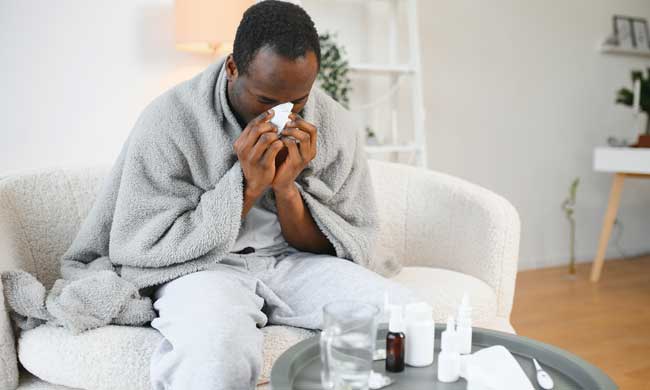HEALTHY LIVING
Tips for caring for a loved one from afar

(Family Features) Caring for a family member or loved one with a serious health condition like Parkinson’s disease (PD) can be a big undertaking and often takes a concerted effort from many family members and friends to provide the best care possible. Even if you’re not available to provide hands-on assistance on a consistent basis, there are ways to provide aid from a distance.
PD is one condition that may have an impact on the entire family, necessitating a broad care network. The second-most common neurodegenerative disorder behind Alzheimer’s disease, PD affects nearly 1 million nationwide, with more than 60,000 Americans newly diagnosed each year. Because it can be hard to tell if a loved one has the disease and no two people experience it quite the same way, some early signs to look for include tremors, slowness of movement and stiffness or rigidity, among others.
Organizations like the Parkinson’s Foundation have resources that can help you and your family members provide long-distance care to a loved one. As an ally to care partners, the Foundation aims to make life better for people living with PD and their families by improving care and advancing research toward a cure.
Experts from the Foundation offer these tips for long-distance caregivers:
Learn about your loved one’s condition. You will be better able to provide support if you have a basic understanding of the disease. Be sure to gather information on the condition’s symptoms, how it is diagnosed and what treatment options are available.
Be well versed in your loved one’s needs. Learn about his or her general health and keep a list of doctors and neighbors along with their contact information. Also keep any pertinent financial and legal documents readily accessible.
Keep an open line of communication with the primary caregiver. As care partner responsibilities often increase over time – and can easily lead to burnout – be sure to let the primary caregiver know you are there for them. Consider sending a simple gift such as a hand-written card, flowers or a gift card for a self-care appointment, like a massage.
Consistently offer to help. There are many ways you can offer support. If in doubt, directly ask how you can be of the most help. Even if you cannot be present to offer hands-on assistance, consider sending meals, troubleshooting technology issues or providing other assistance based on your skillset. You may even offer to have your loved one come stay with you for a while, if they are able to travel, to give the primary caregiver a respite from duties.
Call often. Set a designated day and time each week to chat with your loved one and make the call faithfully, even if just to catch up for a few minutes. Consider using a video calling service so you can see each other, if possible, to provide an additional level of connection.
Talk finances. Many people won’t ask for financial help, even if the limitations of a fixed income mean going without necessities, so it may be best to have this conversation proactively. If a regular subsidy isn’t possible, offer to buy groceries online, send a weekly meal, purchase medical supplies or help with household utility bills, transportation costs or home-related services.
Visit when possible. If your budget allows, plan regular trips to check on your loved one and plan ahead with the primary care partner so you can provide respite. Offer to take on key responsibilities during your visit and provide a listening ear for the main caregiver while you’re there.
You can find an array of free resources, including a comprehensive Caring and Coping guidebook, a video library, podcast episodes, courses and an online community, at Parkinson.org/Caregivers. To learn more and find additional resources in English or Spanish, visit the website or call the Parkinson’s Foundation toll-free Helpline at 1-800-4PD-INFO (1-800-473-4636).
Photos courtesy of Getty Images
SOURCE:
Parkinson’s Foundation
HEALTHY LIVING
Have a heart for caregivers: 8 expert tips for volunteers to care for themselves, too

(Family Features) Survivors of heart attacks or strokes may have additional health and personal care needs, often relying on a family member or close friend to help. While caregivers take on a valuable role, they also pay unique physical and emotional tolls.
In fact, a growing body of scientific research shows people who serve as unpaid caregivers may not get the care they need to live longer, healthier lives, according to the American Heart Association, which is celebrating 100 years of lifesaving service.
Caregiving typically involves a range of duties from providing health care services, such as changing bandages and giving medications, to helping with personal needs like bathing, dressing and meal preparation. Administrative tasks like scheduling medical appointments, filing insurance claims and paying household bills may also be necessary.
The Centers for Disease Control and Prevention reported 1 in 5 U.S. adults provides some form of regular care or assistance to a family member or friend with a health problem or disability; 58% are women and nearly one-third provide care for at least 20 hours per week.
“The typical caregiver likely has an ever-growing and changing to-do list and most of them probably do not add ‘take care of myself’ to that list,” said American Heart Association volunteer Lisa Kitko, Ph.D., R.N., FAHA, dean of the University of Rochester School of Nursing and vice president of the University of Rochester Medical Center. “While caregiving can be a very rewarding experience, it can also take a huge physical and mental toll on even the strongest person.”
Prioritizing your own physical, mental and emotional health allows you to better help your loved one, Kitko said. Consider her tips for caregivers to care for themselves:
- Knowledge is power. Learn everything you can about your loved one’s condition.
- Set boundaries. Say “no” when it’s appropriate, don’t dwell on what you can’t change and recognize you’re trying your best.
- Maintain a healthy diet, limit caffeine and get adequate rest.
- Stay current with your own medical and dental appointments. Inform your health care provider if you’re experiencing any signs of depression.
- Find a support system. Share your feelings with someone who wants to listen or understands what you’re feeling, like the American Heart Association’s online Support Network, which includes a section just for caregivers.
- Nurture your spiritual life and focus on things you’re grateful for each day.
- Make time for yourself and friends. Participate in activities you enjoy, including regular physical activity.
- Be prepared for possible medical emergencies. If you’re caring for someone at risk for heart attack or stroke, recognize the warning signs and call 9-1-1 if he or she experience any. Learn Hands-Only CPR; research shows most out-of-hospital cardiac arrests happen in the home. Be ready to save a life by calling 9-1-1 and pushing hard and fast in the center of the chest.
“‘Take care of yourself so you can take care of others,’ are definitely words to live by for caregivers – everyone tells you that and it certainly makes sense, but it’s hard,” Kitko said. “There is a lot of stress associated with knowing someone is depending on you … That is why taking care of yourself really should be the first item on your caregiver checklist.”
Learn more about caregiving and cardiovascular disease at heart.org.
Photo courtesy of Shutterstock
SOURCE:
American Heart Association
HEALTHY LIVING
What older adults need to know about flu and COVID-19 vaccines

(Family Features) Colder weather brings a change in seasons and often an uptick in flu and COVID-19 cases. The viruses that cause COVID-19 and flu keep changing and infecting thousands of people each year, with older adults being most at risk. The vaccines are updated to provide protection against the viruses currently circulating in communities.
“Vaccines are the best way to prevent serious illness from flu and COVID-19,” said Dr. Nirav D. Shah, principal deputy director of the U.S. Centers for Disease Control and Prevention (CDC). “People who get flu or COVID-19 after getting vaccinated are much less likely than those who did not get a vaccine to get very sick or go to the hospital.”
Here are answers to commonly asked questions about flu and COVID-19 vaccines from the U.S. Department of Health and Human Services Risk Less. Do More. public education campaign.
Which older adults should get vaccinated? The CDC says all people ages 6 months and older should get updated 2024-2025 COVID-19 and flu vaccines. Adults ages 65 and older have the greatest risk of sickness or having to go to the hospital from infection. Getting these vaccines is important for older people who live in nursing homes or other places where a lot of people live together and viruses can spread easily.
When should older adults get vaccinated? The best time to get the flu and COVID-19 vaccines is in September and October. If that’s not possible, then getting vaccinated later in the fall and winter can still help limit serious symptoms. Getting these vaccines early is not recommended given that immunity may start to wane just as respiratory viruses usually peak.
Can older adults get the flu and COVID-19 vaccines together? It is safe for older adults to get both the flu and COVID-19 vaccines at the same time. For most people, it’s also simpler to get them during the same visit. Getting the vaccines in different arms is recommended.
Why should older adults get vaccinated? Vaccines are the best way to protect yourself from serious sickness and death. Older adults have a higher risk of serious illness. As people grow older, their immune systems tend to weaken, and older adults are more likely to have pre-existing health issues that may put them at higher risk. Most people who end up in the hospital for flu orCOVID-19 are older adults – especially older adults who have not been vaccinated. More than 95% of adults who went to the hospital for COVID-19 last year had not gotten the updated vaccine.
What should people who support older adults with their health care decisions know? Flu and COVID-19 vaccines help people risk less severe illness and do more of what they enjoy. Yet many people are unaware of the benefits of these vaccines. That’s why it’s important that people talk with their older family members about getting flu and COVID-19 vaccines this season.
Talk to your doctor about the updated flu and COVID-19 vaccines as well as treatment options. You can also learn more at cdc.gov/RiskLessDoMore.
Photos courtesy of Shutterstock
SOURCE:
United States Department of Health and Human Services
HEALTHY LIVING
Keep cold and flu season at bay

(Family Features) It doesn’t take much for cold and flu symptoms to take over. Even a mild case of the sniffles can make it difficult to navigate the demands of everyday life. It’s virtually impossible to avoid germs altogether, but you can make sure you’re ready to fight off an infection, whether it’s a minor cold or a full-blown case of the flu.
“I always share a few easy and simple methods with my patients when cold and flu season comes back around to keep them in the best shape,” said Dr. Tim Tiutan, board-certified internal medicine physician. “Not only does getting ahead offer protection, but knowing what to do when symptoms start to come on, and what to have in your medicine cabinet, can help ease the burden of an oncoming illness.”
Preparation and prevention play important roles before a bug hits, but it’s also valuable to know how to effectively treat an illness and keep your loved ones from getting sick.
Prevent
Short of stashing yourself away in a bubble, there aren’t many failsafe ways to fully avoid germs. However, some basic hygiene and preventive care can go a long way toward minimizing your risk. Regularly washing your hands can help get rid of germs before you accidentally introduce them to your eyes, mouth or nose. Be especially diligent after spending time in crowded places.
Maintaining an overall healthy lifestyle also helps ensure you’re in optimal condition if you do get sick. That means eating a nutritious, well-rounded diet and keeping up with your exercise routine. Also be sure to talk to your doctor or pharmacist about getting a flu shot; while it may not fully prevent you from getting sick, in most cases it helps your body fight back and keeps your symptoms manageable.
Prepare
Knowing you can’t completely eliminate your exposure to germs, it’s a good idea to ensure you have everything you need to fight a cold or flu on hand. At least once a year, give your medicine cabinet a thorough cleaning. Discard any expired medications and replace products that have run low, especially those designed to help fight symptoms like pain relievers, fever reducers, decongestants, antihistamines and cough syrups.
It’s also a good time to restock items like tissues, cough drops, hand sanitizer and antibacterial soap. Medical supplies like thermometers and humidifiers also come in handy when you’re under the weather; check to be sure yours are in good working order and consider adding any supplies you don’t already have, such as a blood pressure cuff or home oximeter.
Treat
Once you’re sick, sleep is one of the best remedies. Your body can redirect energy toward healing when you’re sleeping, which helps boost your immune system, so give yourself permission to rest when you’re feeling down.
In addition to getting enough rest, it’s important to treat your symptoms, not just mask them. Because symptoms like fever, runny nose, chest congestion, cough and more can indicate a more serious problem, finding the root cause of the symptoms can be a more effective treatment strategy.
For example, some common remedies for chest congestion only mask the symptoms. Many doctors recommend an option like Mucinex 12-Hour because it treats the cause of chest congestion by thinning and loosening excess mucus. One dose lasts up to 12 hours, helping you clear mucus and relieve chest congestion.
Contain
Getting rest and managing your symptoms are easier when you stay at home, but it’s also the best way to prevent spreading germs to others. It’s not always practical, but if you can, limit yourself to one area of the house, away from family members. Cough into your elbow or a tissue, never your hands. Use antibacterial hand sanitizer and wipe down surfaces to minimize others’ contact with your germs.
Be especially wary of spending time with anyone who has a compromised immune system while you’re contagious, including those with pre-existing conditions, older adults and pregnant women. Take advantage of delivery or curbside services for essentials like groceries and talk with your employer about working remotely or using sick time until you’re feeling better.
Find more advice to help fight this cold and flu season at Mucinex.com. https://www.youtube.com/embed/zUpFn6VhRTM?feature=share/?utm_source=familyfeatures&utm_medium=referral&utm_campaign=#17187-Mucinex
When to Call for Help if You’re Feeling Lousy
If you’re experiencing cold symptoms, you might wonder when it’s appropriate to see a doctor for further evaluation. While most colds resolve on their own within a week or two, there are certain instances when seeking medical attention is advisable.
High Fever: If your fever persists for more than three days or reaches 102 F or higher, consult a health care provider.
Persistent or Severe Headaches: If you experience persistent or severe headaches that are not alleviated by over-the-counter medication, it’s advisable to consult a health care provider, as this could indicate a more serious underlying issue.
Persistent Symptoms: If your symptoms worsen or don’t improve after a week, seek medical advice.
Unusual Symptoms: If you experience uncommon or concerning symptoms during a cold, such as extreme fatigue, confusion, dehydration or a high fever that doesn’t respond to treatment, consult your doctor promptly for a proper diagnosis and treatment plan.
Trouble Breathing: Difficulty breathing, chest pain or wheezing can indicate a more severe respiratory condition and warrant medical attention.
High-Risk Individuals: For individuals at high risk of complications from colds, such as pregnant women, the elderly or individuals with conditions like diabetes or heart disease, it’s important to seek advice early to prevent any potential complications.
Remember, your health care provider can offer guidance tailored to your specific situation, helping you manage your cold effectively and ensure optimal recovery.
Photos courtesy of Shutterstock
SOURCE:
Mucinex
-

 NEWS2 years ago
NEWS2 years ago2 hurt, 1 jailed after shooting incident north of Nocona
-

 NEWS12 months ago
NEWS12 months agoSuspect indicted, jailed in Tia Hutson murder
-

 NEWS2 years ago
NEWS2 years agoSO investigating possible murder/suicide
-

 NEWS2 years ago
NEWS2 years agoWreck takes the life of BHS teen, 16
-

 NEWS1 year ago
NEWS1 year agoMurder unsolved – 1 year later Tia Hutson’s family angry, frustrated with no arrest
-

 NEWS1 year ago
NEWS1 year agoSheriff’s office called out to infant’s death
-

 NEWS2 years ago
NEWS2 years agoBowie Police face three-hour standoff after possible domestic fight
-

 NEWS2 years ago
NEWS2 years agoDriver stopped by a man running into the street, robbed at knifepoint





